
Today Netflix raised the price for its most popular streaming package by $1 in the United States, the first rate increase in several years. The move is risky for the company, which faced widespread customer backlash the last time it tried to force a price hike onto customers. But Netflix is facing soaring costs as it pays more to license content from TV studios and television networks while also inking deals to shore up its own slate of original programming. There’s no way for the company to remain profitable in the long term while keeping prices so low.
This time around, Netflix is being more careful with its pricing, offering current customers a two-year reprieve from the price hike. Despite this generous grandfathering, Netflix will be making millions more in revenue almost immediately. A dollar may not seem like much, but that’s a 12.5 percent increase in price in the sector that now comprises 84 percent of Netflix’s total sales (a few people still pay for DVDs by mail in 2014).
Let’s break down just how much extra money Netflix will make on the price hike before any of the service’s current paying members are hit with the increase.
For this analysis to work, we’ll have to make some projections about Netflix’s user growth over the next two years. CEO Reed Hastings has said that he thinks Netflix can get between 60 and 90 million subscribers in the U.S., a huge jump from the 36 million people that now pay for the service. Let’s assume Hastings is right and Netflix keeps adding new members at the torrid pace it’s managed in the last year. Mixing recent Netflix growth and the company’s own projections for Q2 2014, we’ll use these as benchmarks for the company’s quarterly growth, which is highly seasonal:
Q1: 2.67 million new U.S. subscribers
Q2: 0.65 million
Q3: 1.3 million
Q4: 1.79 million
Netflix will of course make the most money from people that sign up today and pay the extra $1 per month for the next two years. It’ll make less from those who subscribe later, and it won’t get an extra dime from me until May 2016, when we old Netflix subscribers can no longer lord our cheaper rates over newer members. If we assume that Netflix members are added on a fairly even monthly basis within each quarter, we can project that people who sign up for Netflix tomorrow will pay $24 more over the next two years than older subscribers. People who sign up in June will pay $23 more. And so on and so forth. Here are some examples of the math:
May 2014: 216,667 new members x $24 in extra fees = $5.2 million more for Netflix
June: 216,667 x 23 = $4.983 million
July: 433,333 x 22 = $9.53 million
August: 433,333 x 21 = $9.10 million
In total, Netflix will generate $148 million in extra revenue from U.S. subscribers alone by inching the price up by $1 for new members. This, of course, is a rough estimate. Netflix could either beat or trail its past performance, and it’s possible some people will opt for the company’s new standard-definition offering, which costs $7.99 per month. I won’t hazard to guess how much it’ll earn from international customers because the price hike varies by country, and Netflix is planning to enter large markets like Germany and France soon. But the company added two million paying international subscribers in the last quarter, a new record. There’s no doubt the price hike will be lucrative abroad, too.
Of course, the real payday comes in May 2016, when older members get hit with the price hike, generating a quick $34.48 million from current U.S. subscribers (assuming they stick around) and $414 million more annually from this large cohort. That will be good timing for some extra funding: Netflix has to pay $3.3 billion in streaming content acquisition costs between 2015 and 2017, according to an SEC filing.
Bask in your glory while you can, OG subscribers. The newbies are going to bring in enough cash to fund another House of Cards.
More Must-Reads From TIME
- The 100 Most Influential People of 2024
- The Revolution of Yulia Navalnaya
- 6 Compliments That Land Every Time
- Stop Looking for Your Forever Home
- If You're Dating Right Now , You're Brave: Column
- The AI That Could Heal a Divided Internet
- Fallout Is a Brilliant Model for the Future of Video Game Adaptations
- Want Weekly Recs on What to Watch, Read, and More? Sign Up for Worth Your Time
Contact us at letters@time.com